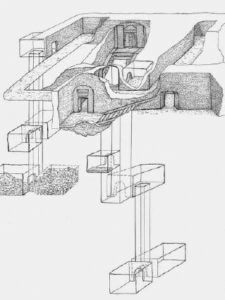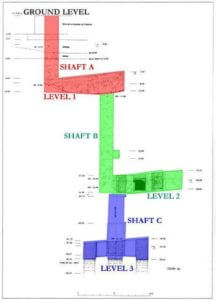
Egypt: Osiris's tomb
 28. 05. 2018
28. 05. 2018

Once you visit Giza, you should know that in addition to the three famous pyramids, there are also many incredible things to explore. One of them is Osiris 'tomb (sometimes also called Osiris' shaft). It is located below the stone path of Rachef's pyramid. This mysterious tomb is intricately excavated in several levels below the surface. Although its existence has been known for several years, it has only recently been properly excavated and documented. The tomb was used for swimming in the past because it was filled with water.
Selim Hassan and his team were among the first to explore the tomb in the 1930s, but only in 1990, Zahi Hawass was fully revealed. The water level gradually declined, 1999 dropped to a level that allowed a detailed survey of the tomb.
Osiris' tomb and its description of Selim Hassan from 1933 - 1934
On the embankment they first built a mastaway-shaped platform, using the stone from the ruined corridor. At the center of the building, they built a shaft about 9 meters deep, passing through the roof and the floor of another underground corridor leading up to the top. In the lower part of this shaft is a rectangular chamber, in the eastern part there is another shaft. It sinks and ends in a side hall surrounded by seven funeral chambers. There is a sarcophagus in each of these chambers. Two of the sarcophagus are basalt monoliths and they are so huge that we first thought they contained bodies of sacred bulls.
It has been found that the shaft has three different levels. The first level was empty. The second level is a tunnel that leads to a room with six other chambers carved into stone walls. Inside these chambers, scientists discovered ceramic shards, ceramic beads and veves (small statuettes).
We also found basalt sarcophagi in chambers C, D and G. The distributed skeletal remains were found in chambers C and G in the sarcophagus. Based on the style, the objects could be classified in the 26th dynasty.
The third level of Osiris' tomb seems to be more complex in terms of design and architecture.
In the deepest part of the Osiris chamber, about 30 meters below the surface, lies the mystery described by Herodotus. Four columns surrounded by walls. Among them, a part of the granite sarcophagus. This finding corresponds to the words of Herodotusthat Cheops was buried in a granite sarcophagus and that water was found near his pyramid. Since the Herodotes itself could not enter the tomb in order to create his writings on the basis of testimony, it is assumed that the writings were created on the basis of an interview with the guardians.
The most important discovery was the red polished ceramics, containing white traces. Experts were able to date ceramics in the 6 period. dynasty (2355-2195 before nl). It means it is probably the oldest material in the whole complex.
The tomb was first opened to the public in 2017. Recently, writer and researcher Brien Foerster studied it. And the result? His view of the Osiris shaft proves that, despite the fact that we know little about ancient Egypt, there are still many details that we have not yet discoveredi.
Brien Foerster and his team plan to return to Giza in April 2019.





 1
1

